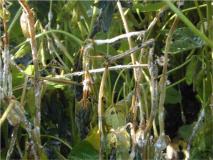WHITE MOLD: NOT TODAY, MAYBE TOMORROW
Jun 26, 2021

Although the warm and dry growing conditions of 2021 haven’t been conducive to development of white mold (Sclerotinia stem rot), things can change quickly – particularly in fields that had heavy white mold pressure in years past. “The need to address white mold doesn’t go away, even if it goes down,” said Kevin Carlson, Federated’s agronomy sales manager.
It’s critical to keep scouting every soybean field – especially if temperatures drop or moderate and/or moisture increases.
Federated recommends Aproach® fungicide as a cost-effective preventive treatment for white mold. Aproach also offers other benefits for plant health that can increase yields, according to Craig Peterson, Federated agronomist at the Ogilvie location.
Aproach is in the strobilurin class of fungicides and can help control both foliar and soil-borne diseases. “It has rapid uptake and fast movement into the plant, which helps if application is delayed for some reason,” said Peterson. Aproach can move in the canopy, “which gives it the ability to get lower to the ground where diseases start,” he said.
One application of Aproach has shown “pretty good suppression,” said Carlson, “but two applications split apart are even better.” One application will not last the entire month that the soybean plants are flowering. Carlson added that if the conditions are right [cooler, wetter], you need to ask whether or not it’s critical to make an application of fungicide to protect from white mold infection. “Hot days are too hot for white mold development,” he said.
Apply Aproach at 9 oz./ac. at full bloom (that is, one flower blooming on every plant); for severe pressure, make a second application seven to 10 days later, also at 9 oz./ac. The best application timing for plant health is at R3, or when there is a 3/16-inch pod on one of the top four nodes, Peterson noted.
Aproach is a moderately priced option; other options (also available from Federated) come with “a higher price tag,” said Carlson, and may provide better white mold suppression – and protect yields.
Talk to your Federated Agronomist to discuss the best fungicide options for your soybean fields.